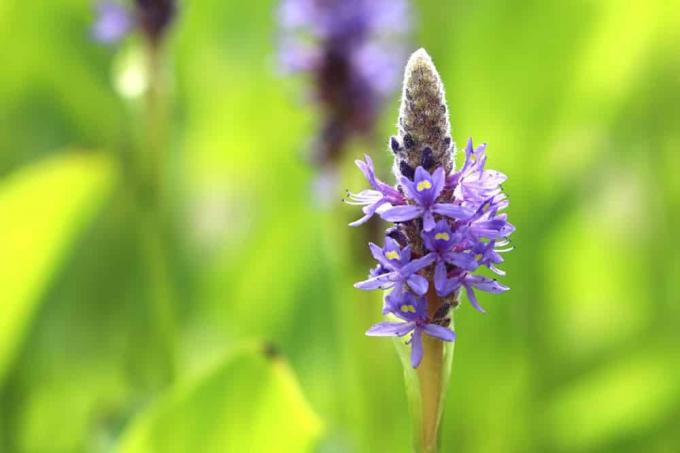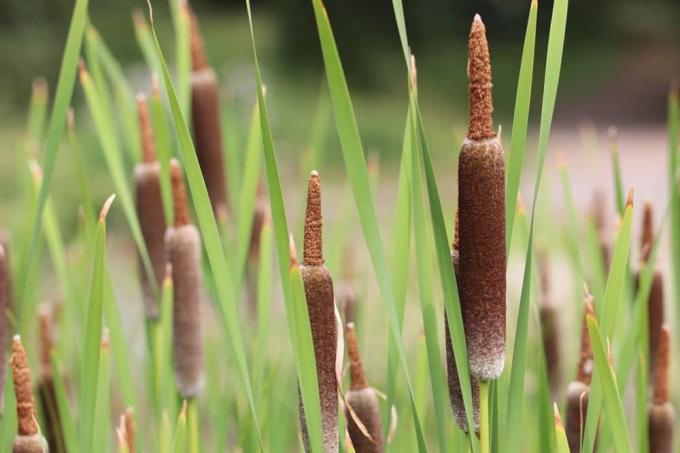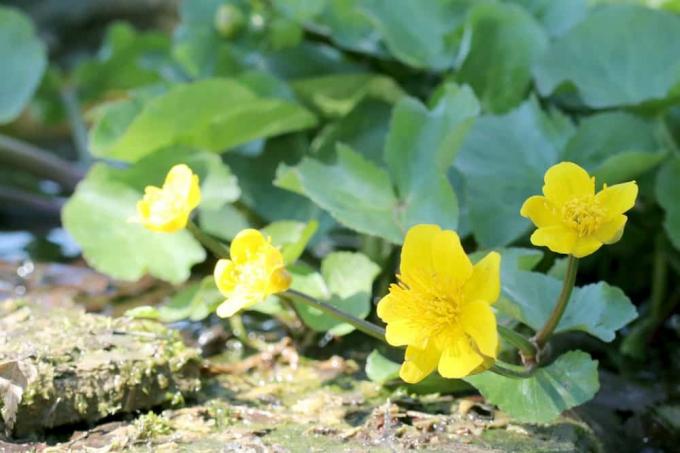

Table of contents
- The native species of underwater plants
- A to N
- Q to W
- Shopping and special care needs
- The pond quickly becomes a nature conservation biotope
Underwater plants are the most important plants in the pond because they ensure that the biological balance in the pond is maintained. However, only those underwater plants that fit in well at the site and do not do additional work themselves should be protected from manual "pond cleaning". Therefore, we present below the native underwater plants that naturally (in both senses) fit best into the pond and are the easiest to care for:
The native species of underwater plants
Underwater plants are urgently needed in every pond: they process all the superfluous nutrients that accumulate in the water and on the bottom over time, eating up the algae in the process pond so much that they cannot multiply excessively (and then turn the pond water into a "cloudy soup"), and feed the organisms living in the pond (including the Microorganisms that live in ponds without fish) with oxygen, down to the bottom of the bed - if none of this happens, the biological balance in the pond will sooner or later change say goodbye.
There are many underwater plants that do all of these jobs; but the native underwater plants are also easy to care for, grow without any problems and do not sprout in winter Trouble (anyone who has ever had to collect dead plants from the bottom of the pond will certainly want this experience in the future waive). Strong arguments for a number of widespread, but also rare and endangered native plants that also It is not our fault that they are not as well known as dandelions and daisies and are therefore presented here become:
A to N
spiked thousand leaf,Myriophyllum spicatum
- Growth height 30 - 100 cm in length
- Water depth: 20 - 150 cm
- robust vigorous
- adaptable cleaning plant
- can regulate the growth of algae alone as a larger stock
thick-leaved waterweed, Egeria densa
- Growth height up to 1 m in length
- Water depth 20 – 150 cm
- very good oxygen donor
Originally native to Brazil and Argentina, but now naturalized worldwide and at least in Europe so far unproblematic, releases oxygen to the pond water even under a layer of ice, attractive health police for the pond Pond.
streaky pondweed,Potamogeton perfoliatus
- Growth height up to 2.5 m long
- Water depth: 50 - 250 cm
- fast growing
- can grow up to 6 m long in optimal natural locations and can easily be cut back
- but is still nothing for mini ponds
frog herb,Luronium natans
- Growth height up to 5 cm
- Water depth: 10 - 40 cm
- domestic rarity
- is under nature protection
- preferably water that is low in nutrients
- prefers soft water
Glossy or Reflecting Pondweed,Potamogeton lucens
- Grows flooding
- but roots under water
- perennial and very decorative oxygen plant
- which stretches its spadix over the water surface for wind pollination
smooth tomentosum,Ceratophyllum submersum
- Growth length up to 80 cm
- Water depth: 20 - 100 cm
- suitable for standing water
- can regulate the growth of algae alone as a larger stock
crab claws, water aloe,Stratiotes aloides
- Floating plant under protection
- which grows freely floating in deeper water
- rooted in shallow water in the ground
Great plant for ponds that are not too small with clean water that is low in lime; With whose settlement you will help to save the endangered dragonfly, a rare species of dragonfly that only lays its eggs on crab claws.
needle ledges,Eleocharis acicularis
- Growth height 5 - 15 cm
- Water depth: 0 – 50 cm
- vigorous and adaptable
- can regulate the growth of algae alone as a larger stock

Q to W
spring moss, Fontinalis antipyretica
- Growth height up to 30 cm in length
- Water depth: 10 - 300 cm
- demanding plant
- who likes to be in a light current
- preferably in clean
- does not grow into nutrient-rich pond water
- Widespread and willing to grow
- Oxygen supplier forming underwater carpets
- which gets excessive algae growth under control
whorled thousand-leaf,Myriophyllum verticillatum
- Growth height up to 2 m under water
- Water depth: 40 - 200 cm
- likes softer water
- can regulate the growth of algae alone as a larger stock
rough chickweed, Ceratophyllum demersum
- Growth length up to 2 m
- Water depth: 20 - 200 cm
- a cleaning devil for every pond
- which, as a larger stock, regulates the growth of algae alone
sea jug,Nymphoides peltata
- Deep-water plant rooting at the bottom
- Water depths of 20 - 60 cm
- up to 150 cm in length
- flowing stems with almost round, dark green leaves
- small yellow flowers floating on the water surface
Rare native pond plant under nature protection, for sunny, warm, nutrient-rich ponds, which sometimes grows somewhat hesitantly, but after that it can become very vigorous and prolific - the popular ornamental plant is therefore unfortunately not for small ones garden ponds.
floating pondweed,Potamogeton natans
- Length up to 1.2 m
- Water depth: 20 - 120 cm
- floating plant rooted in the depths
Smallest native pondweed, but even that should be planted in a basket in small garden ponds.
water spring,Hottonia palustris
- Floating plant with deep roots
- which grows from water depths of 10 to 40 cm to the surface
- but needs a place where it is not pressed by strong competition
- is under nature protection
water buttercup,Ranunculus aquatilis
- Growth height up to 5 cm above the water surface
- Water depths of 20 - 100 cm
- Fine-leaved, vigorous, valuable water purification plant
- for slightly larger garden ponds
- which does not always increase reliably
- feels particularly comfortable in clean, low-lime water
water star,Callitriche palustris
- Roots at the bottom
- grows in water depths up to 50 cm to the surface
- suitable for near-natural ponds
- which supplies them with oxygen even under an ice cover
Tip:
Underwater plants have important tasks in the pond, which they carry out and should carry out for the most part under water; but they are not completely irrelevant for the design of the pond. Because the "colors under water" also have an effect - it makes quite a difference whether the bottom is covered with dense, very light green threads of a thick-leaved one waterweed or whether the delicate, upright shoots of a pondweed with large, oblong leaves rise to the surface shine through.
Shopping and special care needs

There are several species or varieties of many of these native pond plants, especially in very small ponds it depends very much on the growth height and growth speed, which are therefore explored before buying should. If the particular species/cultivar could grow too large for the pond, consider using this plant only then Give it a try if they are placed in a plant basket and so easily moved or removed from the pond can.
If any of these plants start acting a little strangely towards winter, that's not necessarily a cause for concern, though You didn't accidentally purchase an Asian import or a tropical species of native pond plant have. Usually, however, simple information about the growth processes helps:
The waterweed z. B. usually forms winter buds in autumn, from which it will sprout again in spring; in mild winters, however, the whole plant sometimes hibernates. Some of the free-floating plants, such as crab claws, sink to the bottom in autumn and form winter buds as well, reappearing of their own accord in spring. Because of these winter buds, you should no longer move pond plants from August, they are now in the middle of producing winter buds and would no longer take root.
When submerged species have built up dense cushions in late summer, the stocks growing freely in the water should be thinned out in order to give the "pond system" "a good boost" of biomass and nutrients before winter revoke.
The pond quickly becomes a nature conservation biotope
When the underwater plants are thriving and you are adding native marsh and shore plants to the shore area, slowly climb to the Savior of mankind - which is also less necessary, because our insect populations have fallen dramatically in recent decades are. The plants at the edge of the pond delight aquatic and terrestrial insects with their leaves and flowers; and there are also some plants that need to be saved themselves because they have become so rare that they are protected.
If you don't just buy any bank vegetation, but e.g. B. like broad-leaved cotton grass (Eriophorum latifolium), creeping celery (Helosciadium repens), pill fern (Pilularia globulifera), Ostrich loosestrife (Lysimachia thyrsifolia), marsh gladioli (Gladiolus palustris), devil's bit (Succisa pratensis), meadow irises (Iris sibirica) and/or dwarf cattails (Typha minima), you should therefore kill several birds in relation to nature conservation one flap.
Tip:
The biological balance, to maintain the underwater plants in the pond and the Contributing plants around the pond is also important in ponds where never a single fish should swim. If the pond owner does not use any animals himself, this makes a pond (which, in contrast to the "water-filled design object", an image of a natural body of water in should bring to the garden) is not much "inanimate" - long before any fish, innumerable amounts of microorganisms worry about the living conditions in the Pond. In addition, the aquatic plants also regularly save the lives of larger animals in the pond without fish: insect larvae, tadpoles, newts and other creatures that have settled there by themselves urgently need the dense stock of plants in and around the pond, because otherwise they would not hide from predators can.
 garden editorial
garden editorial I write about everything that interests me in my garden.
Learn more about pond plants

Waterweed, Elodea densa - care from A to Z
Waterweed is one of the fast-growing aquatic plants that can adapt extremely well to a wide variety of water conditions. Not only does it do well in the garden pond, the Elodea densa can also be used in freshwater aquariums.

Marsh iris, Iris pseudacorus: care from A to Z
A pond is a special attraction in the garden and with the right planting it becomes an eye-catcher. A frequently used aquatic plant is the somewhat exotic-looking marsh or water iris. It is the perfect pond plant, which also has special properties.

Hechtkraut, Pontederia: care from A - Z | 5 tips for wintering
Hechtkraut belongs to the water hyacinths and originally comes from America. However, it has also been cultivated since the 16th century, as it fulfills important functions on the shores of lakes and ponds. Interested hobby gardeners can find out here how care and overwintering should look like.

Cattails: care from A-Z | 8 tips for propagation & cutting
The bulrush is a popular plant for natural gardens with large bodies of water. As marsh plants, the Typha species have special requirements for their location and care is more complex. With targeted measures and the right combination of species, you can reduce the maintenance effort.

Marsh marigold in the pond: location, care and propagation
The marsh marigold (Caltha palustris) is a real early bloomer and the first flowering plant in the garden pond. In spring it shows its bright yellow flowers, which illuminate the edges of ponds and water bodies as well as wet meadows. It is a good plant partner and very easy to care for.

Cut reeds, but when? Instructions + info at the best time
Green reeds are often planted because they grow incredibly fast. It will fill any suitable spot in just one gardening season. Sometimes, however, more stalks sprout than the gardener would like. When can he give the reed a short cut?



